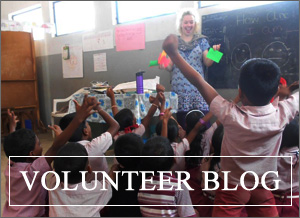When I arrived at my new school, many classrooms didn’t have any visual aids on the walls. I thought it would great to create a few engaging, colourful displays to help stimulate the kids and it proved to be a get way to get them all interacting with me.
Here are some ideas for visual aids you can put up on the walls in your classroom. Some are posters that you might be able to buy (check out bookshops in the nearest big city or town to your overseas teaching placement), make yourself (while away those sunny Sri Lankan afternoons with some coloured pens and poster paper), or get the students to help you make them by building lessons around the topic.
- Body parts: an outline of a human body with the common body parts labelled (note: in Sri Lanka and India some people are taught that hand means arm and that arm means hand). You can use a child from your class to draw around if you want a life-size display! An extension to this visual aid was to make various things that could be stuck on top of the person: outfits, items of clothing, objects used by people if various roles etc. etc.
- Vocabulary posters: fruits, vegetables, household items, classroom items, colours, family members, buildings, vehicles, sports, hobbies, etc. This can be extended as you develop a dialogue or involve role-play or conversation work.
- Song words: Chester, 10 Green Bottles, Row Your Boat, Incy Wincy Spider, etc. It’s hard enough for me to remember all the words so having a visual aid (with pictures that the kids make to visualise the lines of the songs) is a great help to both children and teachers!
- Tongue twisters: mixed biscuits, red lorry yellow lorry, she sells seashells by the sea shore, I want a proper cup of coffee from a proper copper coffee pot, etc. A possible extension to this is to make an end-of-class game of saying the tongue twisters. You can add team stars to the displays to make it a little competitive which gets them practicing at home too – it’s amazing what kids will do to get a star on the wall for their team.
- Parts of speech : a poster for nouns, one for adjectives, adverbs, verbs, etc. You can aim this type of display at an appropriate level for your class. It’s always advisable to aim high and work towards your class getting to grips with things.
Tip – Remembering to refer back to you visual aids repeatedly is really important. This reinforces their use as a resource and not just as a pretty wall hanging… it also helps you to get ideas of how to extend your lessons if questions come up or you find yourself using the visual aid in ways you’d not originally thought of… such as using them to help tell a story or help invent a story with your class. It’s also important to not be afraid of changing them or adding to them – if you’re in the habit of regularly adding things the kids start to get excited about what might have changed this lesson…
Finally, don’t worry about what your displays look like; you don’t have to be Van Gogh and there’s nothing wrong with having to use a bit of imagination to see that your bowl of ‘fruit’ really is a bowl of fruit!



Comments are closed.